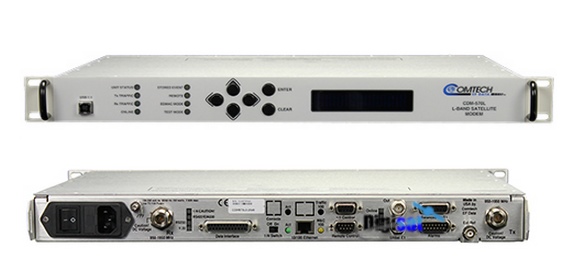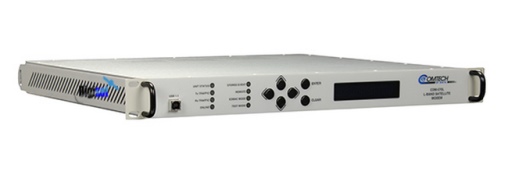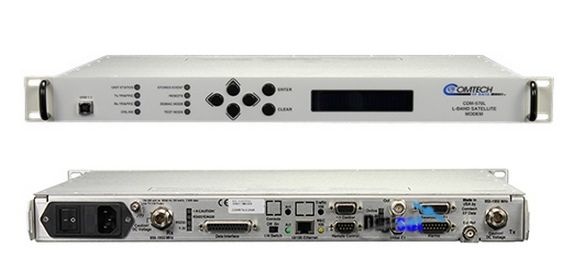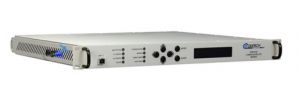Comtech CDM-570L & CDM-570L-IP Broadband IP Satellite Modems
L-Band Input, Flexible Modulation Options, Variable rate from 2.4 Kbps to 9.98 Mbps
CDM-570L & CDM-570L-IP Broadband IP Satellite Modems
This product has been designated end of life by the manufacturer. Please contact us for info on a suitable replacement.
The Comtech EF Data Series CDM-570L L-Band Satellite Modem offers variable data rate operation from 2.4 Kbps to 9.98 Mbps and supports all of the popular modulation types such as: BPSK, QPSK, OQPSK, 8-PSK, Patented 8-QAM, 16-QAM. The CDM-570L works with all BUCs and can be configured with and without a BUC power supply. In addition to the CDM-570L, this modem can be configured for IF-band operation from 50 to 90 Mhz or 100 to 180 Mhz. An optional IP board is also available for the 570 which provides 10/100Base-T Ethernet port (CDM-570-IP,CDM-570L-IP, CDM-570-IPEN, CDM-570L-IPEN). . 
Turbo Coding
The Comtech CDM-570L Series Brodaband Satellite Modems provide Turbo FEC which delivers exceptional performance and increased coding gain which enables exceptional bandwidth savings. Numerous additional custom options can be added in order to tailor the Comtech 570 to your exact requirements. The CDM570 offers lower decoding delays, and great bandwidth savings when compared to traditional modulation schemes.

IP Module
With its innovative architecture and support for advanced capabilities, IP Module-equipped versions of the CDM-570/L allow for efficient IP networking and transport over satellite. The CDM-570/L-IP supports a wide range of applications and network topologies.
Header Compression Option
Configurable on a per route basis, header compression reduces the bandwidth required for VoIP by as much as 60%. Example: A G.729 voice codec, operating at 8 kbps, requires 32 kbps bandwidth once encapsulated into an IP/UDP/RTP frame. With compression, the same voice call needs only 10.8 kbps total WAN satellite bandwidth. Typical Web/HTTP traffic can also be reduced by 10% via IP/TCP header compression.
Payload Compression Option
Configurable on a per route basis, payload compression can reduce the required satellite bandwidth by up to 40%.
Quality of Service (QoS) Option
The modems support multi-level QoS to reduce jitter and latency for real time traffic, provides priority treatment to mission critical applications and allows non-critical traffic to use the remaining bandwidth.
Supported modes are:
• DiffServ – Industry-standard method of providing QoS enabling seamless co-existence in networks that implement DiffServ.
• Max/Priority – Provides eight levels of traffic prioritization with the ability to limit maximum traffic per priority class
• Min/Max – Provides a Committed Information Rate (CIR) to each user defined class of traffic with the ability to allow a higher
burstable rate depending on availability
|
Frequency Range |
CDM-570 & CDM-570-IP: 50 to 90 or 100 to 180 MHz, 100 Hz resolution CDM-570L & CDM-570L-IP: 950 to 2000 MHz, 100 Hz resolution |
|
Data Interfaces |
EIA-422/-530 DCE, V.35 DCE, Sync EIA-232, 10/100Base-T Ethernet (option), G.703 T1 balanced (option), G.703 E1 balanced or unbalanced (option) |
|
Data Rate Range (See user manual for details) |
2.4 kbps to 9.98 Mbps (depending on modulation, FEC and framing), 1 bps step with fully independent TX and RX rates |
|
Modulation & FEC |
Data Rate Range |
|
5/16 BPSK TPC |
2.4 kbps to 0.937 Mbps |
|
21/44 BPSK TPC |
2.4 kbps to 1.430 Mbps |
|
1/2 BPSK |
2.4 kbps to 1.500 Mbps |
|
1/2 QPSK/OQPSK |
4.8 kbps to 3.000 Mbps |
|
3/4 QPSK/OQPSK |
7.2 kbps to 4.500 Mbps |
|
7/8 QPSK/OQPSK |
8.4 kbps to 5.250 Mbps |
|
2/3 8PSK TCM |
8.7 kbps to 4.400 Mbps |
|
21/44 QPSK/OQPSK TPC |
4.8 kbps to 2.860 Mbps |
|
3/4 QPSK/OQPSK TPC |
7.2 kbps to 4.500 Mbps |
|
7/8 QPSK/OQPSK TPC |
8.4 kbps to 5.250 Mbps |
|
0.95 QPSK/OQPSK TPC |
9.1 kbps to 5.666 Mbps |
|
3/4 8PSK/8-QAM TPC |
10.8 kbps to 6.750 Mbps |
|
7/8 8PSK/8-QAM TPC |
13.6 kbps to 7.875 Mbps |
|
0.95 8PSK/8-QAM TPC |
15.3 kbps to 8.500 Mbps |
|
3/4 16-QAM TPC |
14.4 kbps to 9.000 Mbps |
|
7/8 16-QAM TPC |
16.8 kbps to 9.980 Mbps |
|
Uncoded BPSK |
4.8 kbps to 3.000 Mbps |
|
Uncoded QPSK/OQPSK |
9.6 kbps to 5.000 Mbps |
|
FEC Options Viterbi |
Rate 1/2 BPSK, QPSK/OQPSK Rate 3/4 and 7/8 QPSK/OQPSK and 16-QAM w/RS |
|
TCM |
8PSK 2/3 (Closed network – not IESS-310) |
|
Turbo Product Coding |
Rate 21/44 BPSK, 5/16 BPSK, Rate 21/44 QPSK/OQPSK Rate 3/4 and Rate 7/8 QPSK/OQPSK, 8PSK/8-QAM and 16-QAM Rate 0.95 QPSK/OQPSK and 8PSK/8-QAM |
|
Reed-Solomon |
Proprietary 220/200 and 200/180 modes available |
|
Uncoded |
BPSK, QPSK/OQPSK |
|
M&C Interface |
EIA-232, EIA-485 (2-or 4-wire), Ethernet 10/100Base-T (dependent on operational mode) |
|
Input/Output Impedance |
CDM-570 & CDM-570-IP: matched for 50/75 n, BNC connector CDM-570L & CDM-570L-IP: transmit and receive 50 n, female Type N connector |
|
External Reference Input |
1, 2, 5, 10 or 20 MHz, BNC connector |
|
Form C Relays |
TX, RX traffic alarms and unit faults |
|
CDM-570 & CDM-570-IP |
CDM-570L & CDM-570L-IP |
|
||
|
Frequency Stability |
±1 ppm, 0º to 50ºC (32º to 122ºF) |
±0.06 ppm, 0º to 50ºC (32º to 122ºF) |
||
|
Output Power |
0 to –25 dBm, 0.1 dB steps |
0 to –40 dBm, 0.1 dB steps |
||
|
Accuracy |
± 0.5 dB over frequency and temperature |
± 1.0 dB over frequency and temperature |
||
|
Phase Noise |
< 0.75 degrees RMS double-sided, 100 Hz to 1 MHz |
< 1.2 degrees RMS double-sided, 100 Hz to 1 MHz |
||
|
Output Spectrum/ Filtering |
Meets IESS-308/-309 power spectral mask |
|||
|
Harmonics and Spurious |
< -55 dBc/4 kHz (typically < -60 dBc/4 kHz) |
|||
|
Transmit On/Off Ratio |
55 dB minimum |
|||
|
External TX Carrier Off |
By TTL LOW signal, or RTS |
|||
|
TX Clock Options |
Internal (SCT), external (TT), loop timing with symmetric or asymmetric operation (data interface dependent) |
|||
|
CDM-570 & CDM-570-IP |
CDM-570L & CDM-570L-IP |
|
||
|
Input Power Range |
-30 to -60 dBm |
-130 + 10 log symbol rate, dBm (minimum) -90 + 10 log symbol rate, dBm (maximum) |
||
|
Max Composite Level |
+35 dBc, up to -5 dBm absolute max. |
+40 dBc, up to -10 dBm absolute max. |
||
|
Acquisition Range |
± 1 to ± 32 kHz, 1 kHz step |
± 1 to ± 32 kHz, 1 kHz step, symbol rate <= 625 ksps ± 1 to ± 200 kHz, 1 kHz step, symbol rate > 625 ksps |
||
|
Acquisition Time |
Highly dependent on data rate, FEC rate, and demodulator acquisition range. Example: 120 ms average at 64 kbps, Rate 1/2 QPSK, ± 10 kHz acquisition sweep range, 6dB Eb/No |
|||
|
Receive Buffer |
512, 1024, 2048, 4096, 8182, or 16384 bits |
|||
|
Receive Clock Options |
Buffer disabled (RX satellite), buffer enabled (symmetric or asymmetric operation) (data interface dependent) |
|||
|
Clock Tracking |
± 100 ppm minimum |
|||
|
Monitor Functions |
Eb/No, frequency offset, BER, buffer fill status, RX signal level |
|||
|
Temperature |
Operating: 0 to 50°C (32 to 122°F) |
|
|
Storage: -25 to 85°C (-13 to 185°F) |
|
|
|
Power Supply |
100 to 240 VAC, 50/60 Hz -24 VDC (HW option) -48 VDC (HW option) |
|
|
Power Consumption (See Manual) |
CDM-570: 29 W typical (32 W max.) CDM-570-IP: 37 W typical CDM-570L: 29 W typical (32 W max.) w/o BUC CDM-570L-IP: 37 W typical w/o BUC |
|
|
Dimensions (height x width x depth) |
CDM-570-IP: 1.75” x 19” x 12” (4.4 x 48.3 x 30.5 cm) CDM-570L-IP: 1.75” x 19” x 16” (4.4 x 48.3 x 40.6 cm) |
|
|
Weight |
CDM-570 & CDM-570-IP: 6 lbs (2.7 kg) CDM-570L: 7 lbs (3.2 kg) (without BUC P/S) CDM-570L & CDM-570L-IP: 16 lbs (7.2 kg) including 150 W BUC power supply |
|
Typical Users
- • Enterprise
- • Internet Service Providers
- • Satellite Service Providers
- • Offshore & Maritime
- • Mobile Operators
Common Applications
- • Mobile Backhaul
- • Communications on-the-Move
- • Disaster Recovery & Emergency Communications
- • Enterprise
- • Offshore & Maritime Communications
- • Satellite News Gathering



